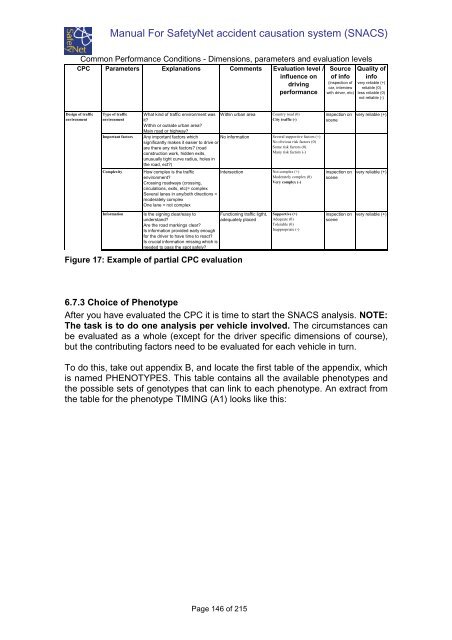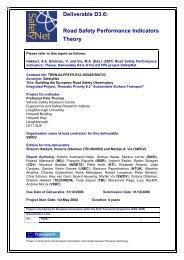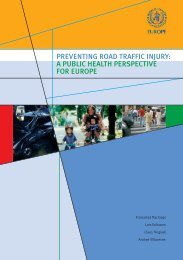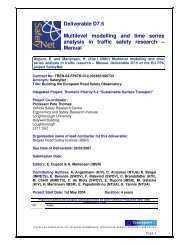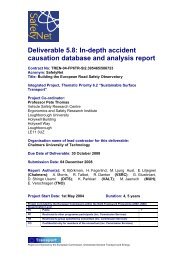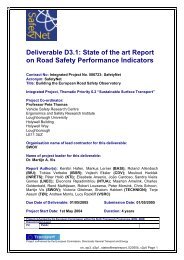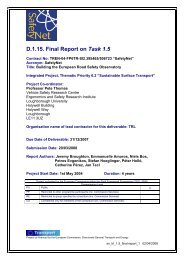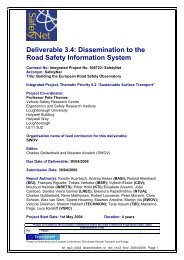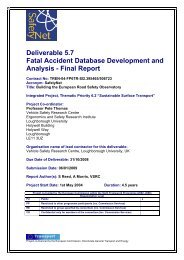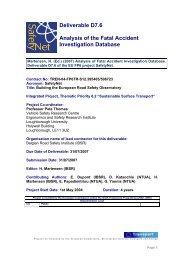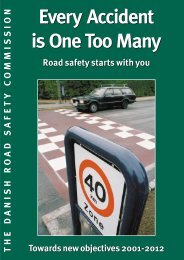Glossary of Data Variables for Fatal and accident causation ... - ERSO
Glossary of Data Variables for Fatal and accident causation ... - ERSO
Glossary of Data Variables for Fatal and accident causation ... - ERSO
You also want an ePaper? Increase the reach of your titles
YUMPU automatically turns print PDFs into web optimized ePapers that Google loves.
Manual For SafetyNet <strong>accident</strong> <strong>causation</strong> system (SNACS)<br />
Common Per<strong>for</strong>mance Conditions - Dimensions, parameters <strong>and</strong> evaluation levels<br />
CPC Parameters Explanations Comments Evaluation level /<br />
influence on<br />
driving<br />
per<strong>for</strong>mance<br />
Source<br />
<strong>of</strong> info<br />
(inspection <strong>of</strong><br />
car, interview<br />
with driver, etc)<br />
Quality <strong>of</strong><br />
info<br />
very reliable (+)<br />
reliable (0)<br />
less reliable (0)<br />
not reliable (-)<br />
Design <strong>of</strong> traffic<br />
environment<br />
Type <strong>of</strong> traffic<br />
environment<br />
Important factors<br />
Complexity<br />
In<strong>for</strong>mation<br />
What kind <strong>of</strong> traffic environment was<br />
it<br />
Within or outside urban area<br />
Main road or highway<br />
Any important factors which<br />
significantly makes it easier to drive or<br />
are there any risk factors (road<br />
construction work, hidden exits,<br />
unusually tight curve radius, holes in<br />
the road, ect)<br />
Within urban area Country road (0)<br />
City traffic (-)<br />
No in<strong>for</strong>mation Several supportive factors (+)<br />
No obvious risk factors (0)<br />
Some risk factors (0)<br />
Many risk factors (-)<br />
How complex is the traffic<br />
environment<br />
Crossing roadways (crossing,<br />
circulations, exits, etc)= complex<br />
Several lanes in any/both directions =<br />
moderately complex<br />
One lane = not complex<br />
Intersection Not complex (+)<br />
Moderately complex (0)<br />
Very complex (-)<br />
Is the signing clear/easy to<br />
Functioning traffic ligtht,<br />
underst<strong>and</strong><br />
adequately placed<br />
Are the road markings clear<br />
Is in<strong>for</strong>mation provided early enough<br />
<strong>for</strong> the driver to have time to react<br />
Is crucial in<strong>for</strong>mation missing which is<br />
needed to pass the spot safely<br />
Figure 17: Example <strong>of</strong> partial CPC evaluation<br />
Supportive (+)<br />
Adequate (0)<br />
Tolerable (0)<br />
Inappropriate (-)<br />
inspection on<br />
scene<br />
inspection on<br />
scene<br />
inspection on<br />
scene<br />
very reliable (+)<br />
very reliable (+)<br />
very reliable (+)<br />
6.7.3 Choice <strong>of</strong> Phenotype<br />
After you have evaluated the CPC it is time to start the SNACS analysis. NOTE:<br />
The task is to do one analysis per vehicle involved. The circumstances can<br />
be evaluated as a whole (except <strong>for</strong> the driver specific dimensions <strong>of</strong> course),<br />
but the contributing factors need to be evaluated <strong>for</strong> each vehicle in turn.<br />
To do this, take out appendix B, <strong>and</strong> locate the first table <strong>of</strong> the appendix, which<br />
is named PHENOTYPES. This table contains all the available phenotypes <strong>and</strong><br />
the possible sets <strong>of</strong> genotypes that can link to each phenotype. An extract from<br />
the table <strong>for</strong> the phenotype TIMING (A1) looks like this:<br />
Page 146 <strong>of</strong> 215


